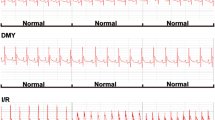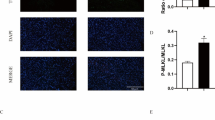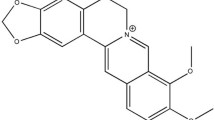Abstract
In this study, we evaluated the effect of curcumin (Cur) post-treatment on isolated perfused rat hearts that had been subjected to a protocol of ischemia and reperfusion injury. We also examined whether the Janus kinase 2 and signal transducer and activator 3 of transcription (JAK2/STAT3) signaling pathway plays a role in the cardioprotective effects of Cur post-treatment. Isolated perfused rat hearts were subjected to 60 min of ischemia, followed by 60 min of reperfusion. The hearts were exposed to 1-μM Cur during the first 10 min of reperfusion in the absence or presence of the JAK kinase-specific inhibitor AG490 (AG, 1 μM). The Cur treatment conferred a cardioprotective effect, and the treated hearts demonstrated an improved post-ischemic cardiac functional recovery, a decreased myocardial infarct size and decreased lactate dehydrogenase release in the coronary flow, a reduced number of apoptotic cardiomyocytes, up-regulation of the anti-apoptotic protein Bcl2 and down-regulation of the pro-apoptotic protein Caspase3. AG blocked the Cur-mediated cardioprotection by inhibiting the JAK2/STAT3 signaling pathway, as reflected by the abrogation of the Cur-induced up-regulation of Bcl2 and down-regulation of Caspase3. The results suggest that Cur post-treatment can attenuate IR injury through the activation of the JAK2/STAT3 signaling pathway, which transmits a survival signal to the myocardium.







Similar content being viewed by others
Abbreviations
- Cur:
-
Curcumin
- AG, AG490:
-
A specific inhibitor of the JAK2/STAT3 signaling pathway
- IR:
-
Ischemia and reperfusion
- JAK2/STAT3:
-
Janus kinase 2 and signal transducer and activator 3 of transcription protein
- LVEDP:
-
Left ventricular end-diastolic pressure
- LVDP:
-
Left ventricular peak develo** pressure
- HR:
-
Heart rate
- CF:
-
Coronary flow, the volume of buffer that overflowed out of an isolated heart chamber during a 1 min interval
- DP:
-
The index of cardiac contractile function = (HR × LVDP)/1,000
- +dP/dt max:
-
The maximum rate of pressure change in the ventricle
- TUNEL:
-
Terminal deoxynucleotidyl transferase dUTP nick end labeling assay
- DAPI:
-
4′, 6-diamidino-2-phenylindole
References
Ali MS, Mudagal MP, Goli D (2009) Cardioprotective effect of tetrahydrocurcumin and rutin on lipid peroxides and antioxidants in experimentally induced myocardial infarction in rats. Pharmazie 64:132–136. doi:10.1691/ph.2008.8628
Ammon HP, Wahl MA (1991) Pharmacology of Curcuma longa. Planta Med 57:1–7. doi:10.1055/s-2006-960004
Awad AS, El-Sharif AA (2011) Curcumin immune-mediated and anti-apoptotic mechanisms protect against renal ischemia/reperfusion and distant organ induced injuries. Int Immunopharmacol 11:992–996. doi:10.1016/j.intimp.2011.02.015
Basgut B, Kayki G, Bartosova L, Ozakca I, Seymen A, Kandilci HB, Ugur M, Turan B, Ozcelikay AT (2010) Cardioprotective effects of 44Bu, a newly synthesized compound, in rat heart subjected to ischemia/reperfusion injury. Eur J Pharmacol 640:117–123. doi:10.1016/j.ejphar.2010.04.045
Boengler K, Hilfiker-Kleiner D, Drexler H, Heusch G, Schulz R (2008) The myocardial JAK/STAT pathway: from protection to failure. Pharmacol Ther 120:172–185. doi:10.1016/j.pharmthera.2008.08.002
Boengler K, Hilfiker-Kleiner D, Heusch G, Schulz R (2010) Inhibition of permeability transition pore opening by mitochondrial STAT3 and its role in myocardial ischemia/reperfusion. Basic Res Cardiol 105:771–785. doi:10.1007/s00395-010-0124-1
Bolli R, Dawn B, Xuan YT (2003) Role of the JAK-STAT pathway in protection against myocardial ischemia/reperfusion injury. Trends Cardiovasc Med 13:72–79. doi:10.1038/ki.2008.605
Caceres-Cortes JR (2008) A potent anti-carcinoma and anti-acute myeloblastic leukemia agent, AG490. Anticancer Agents Med Chem 8:717–722. doi:10.2174/187152008785914752
Cheng AL, Hsu CH, Lin JK, Hsu MM, Ho YF, Shen TS, Ko JY, Lin JT, Lin BR, Ming-Shiang W, Yu HS, Jee SH, Chen GS, Chen TM, Chen CA, Lai MK, Pu YS, Pan MH, Wang YJ, Tsai CC, Hsieh CY (2001) Phase I clinical trial of curcumin, a chemopreventive agent, in patients with high-risk or premalignant lesions. Anticancer Res 21:2895–2900. doi:10.1110/ps.0212902
Cheng H, Liu W, Ai X (2005) Protective effect of curcumin on myocardial ischemia reperfusion injury in rats. Zhong Yao Cai 28:920–922. doi:CNKI:SUN:ZYCA.0.2005-10-026
Chen KH, Chao D, Liu CF, Chen CF, Wang D (2010) Curcumin attenuates airway hyperreactivity induced by ischemia–reperfusion of the pancreas in rats. Transplant Proc 42:744–747. doi:10.1016/j.transproceed.2010.03.017
Claeys MJ, Bosmans J, De Ceuninck M, Beunis A, Vergauwen W, Vorlat A, Vrints CJ (2004) Effect of intracoronary adenosine infusion during coronary intervention on myocardial reperfusion injury in patients with acute myocardial infarction. Am J Cardiol 94:9–13. doi:10.1016/j.amjcard.2004.03.021
Dhandapani KM, Mahesh VB, Brann DW (2007) Curcumin suppresses growth and chemoresistance of human glioblastoma cells via AP-1 and NFkappaB transcription factors. J Neurochem 102:522–538. doi:10.1111/j.1471-4159.2007.04633.x
Fiorillo C, Becatti M, Pensalfini A, Cecchi C, Lanzilao L, Donzelli G, Nassi N, Giannini L, Borchi E, Nassi P (2008) Curcumin protects cardiac cells against ischemia–reperfusion injury: effects on oxidative stress, NF-kappaB, and JNK pathways. Free Radic Biol Med 45:839–846. doi:10.1016/j.freeradbiomed.2008.06.013
Frias MA, Lang U, Gerber-Wicht C, James RW (2010) Native and reconstituted HDL protect cardiomyocytes from doxorubicin-induced apoptosis. Cardiovasc Res 85:118–126. doi:10.1093/cvr/cvp289
Frias MA, Somers S, Gerber-Wicht C, Opie LH, Lecour S, Lang U (2008) The PGE2-Stat3 interaction in doxorubicin-induced myocardial apoptosis. Cardiovasc Res 80:69–77. doi:10.1093/cvr/cvn171
Fuglesteg BN, Suleman N, Tiron C, Kanhema T, Lacerda L, Andreasen TV, Sack MN, Jonassen AK, Mjøs OD, Opie LH, Lecour S (2008) Signal transducer and activator of transcription 3 is involved in the cardioprotective signalling pathway activated by insulin therapy at reperfusion. Basic Res Cardiol 103:444–453. doi:10.1007/s00395-008-0728-x
Hausenloy DJ, Baxter G, Bell R, Bøtker HE, Davidson SM, Downey J, Heusch G, Kitakaze M, Lecour S, Mentzer R, Mocanu MM, Ovize M, Schulz R, Shannon R, Walker M, Walkinshaw G, Yellon DM (2010) Translating novel strategies for cardioprotection: the Hatter Workshop Recommendations. Basic Res Cardiol. doi:105:677-8610.1007/s00395-010-0121-4
Heusch G (2010) Adenosine and maximum coronary vasodilation in humans: myth and misconceptions in the assessment of coronary reserve. Basic Res Cardiol 105:1–5. doi:10.1007/s00395-009-0074-7
Heusch G, Boengler K, Schulz R (2010) Inhibition of mitochondrial permeability transition pore opening: the Holy Grail of cardioprotection. Basic Res Cardiol 105:151–154. doi:10.1007/s00395-009-0080-9
Heusch G, Musiolik J, Gedik N, Skyschally A (2011) Mitochondrial STAT3 activation and cardioprotection by ischemic postconditioning in pigs with regional myocardial ischemia/reperfusion. Circ Res 109:1302–1308. doi:1161/CIRCRESAHA.111.255604
Heusch G, Musiolik J, Kottenberg E, Peters J, Jakob H, Thielmann M (2012) STAT5 activation and cardioprotection by remote ischemic preconditioning in humans: short communication. Circ Res 110:111–115. doi:10.1161/CIRCRESAHA.111.259556
** ZX, Zhou JJ, **n M, Peng DR, Wang XM, Bi SH, Wei XF, Yi DH (2007) Postconditioning the human heart with adenosine in heart valve replacement surgery. Ann Thorac Surg 83:2066–2072. doi:10.1016/j.athoracsur.2006.12.031
Karatepe O, Gulcicek OB, Ugurlucan M, Adas G, Battal M, Kemik A, Kamali G, Altug T, Karahan S (2009) Curcumin nutrition for the prevention of mesenteric ischemia–reperfusion injury: an experimental rodent model. Transplant Proc 41:3611–3616. doi:10.1016/j.transproceed.2009.08.002
Kelly RF, Lamont KT, Somers S, Hacking D, Lacerda L, Thomas P, Opie LH, Lecour S (2010) Ethanolamine is a novel STAT-3 dependent cardioprotective agent. Basic Res Cardiol 105:763–770. doi:10.1007/s00395-010-0125-0
Kurup VP, Barrios CS (2008) Immunomodulatory effects of curcumin in allergy. Mol Nutr Food Res 52:1031–1039. doi:10.1002/mnfr.200700293
Madhani M, Hall AR, Cuello F, Charles RL, Burgoyne JR, Fuller W, Hobbs AJ, Shattock MJ, Eaton P (2010) Phospholemman Ser69 phosphorylation contributes to sildenafil-induced cardioprotection against reperfusion injury. Am J Physiol Heart Circ Physiol 299:H827–H836. doi:10.1152/ajpheart.00129.2010
Marzilli M, Orsini E, Marraccini P, Testa R (2000) Beneficial effects of intracoronary adenosine as an adjunct to primary angioplasty in acute myocardial infarction. Circulation 101:2154–2159. doi:10.1161/ 01.CIR.101.18.2154
Mascareno E, El-Shafei M, Maulik N, Sato M, Guo Y, Das DK, Siddiqui MA (2001) JAK/STAT signaling is associated with cardiac dysfunction during ischemia and reperfusion. Circulation 104:325–329. doi:10.1161/ 01.CIR.104.3.325
McCormick J, Barry SP, Sivarajah A, Stefanutti G, Townsend PA, Lawrence KM, Eaton S, Knight RA, Thiemermann C, Latchman DS, Stephanou A (2006) Free radical scavenging inhibits STAT phosphorylation following in vivo ischemia/reperfusion injury. FASEB J 20:2115–2117. doi:10.1096/fj.06-6188fje
Moussavian MR, Scheuer C, Schmidt M, Kollmar O, Wagner M, von Heesen M, Schilling MK, Menger MD (2011) Multidrug donor preconditioning prevents cold liver preservation and reperfusion injury. Langenbecks Arch Surg 396:231–241. doi:10.1007/s00423-010-0668-4
Ohori H, Yamakoshi H, Tomizawa M, Shibuya M, Kakudo Y, Takahashi A, Takahashi S, Kato S, Suzuki T, Ishioka C, Iwabuchi Y, Shibata H (2006) Synthesis and biological analysis of new curcumin analogues bearing an enhanced potential for the medicinal treatment of cancer. Mol Cancer Ther 5:2563–2571. doi:10.1158/1535-7163.MCT-06-0174
Omura T, Yoshiyama M, Ishikura F, Kobayashi H, Takeuchi K, Beppu S, Yoshikawa J (2001) Myocardial ischemia activates the JAK-STAT pathway through angiotensin II signaling in vivo myocardium of rats. J Mol Cell Cardiol 33:307–316. doi:10.1006/jmcc.2000.1303
Ovize M, Baxter GF, Di Lisa F, Ferdinandy P, Garcia-Dorado D, Hausenloy DJ, Heusch G, Vinten-Johansen J, Yellon DM, Schulz R (2010) Postconditioning and protection from reperfusion injury: where do we stand? Position paper from the Working Group of Cellular Biology of the Heart of the European Society of Cardiology. Cardiovasc Res 87:406–423. doi:10.1093/cvr/cvq129
Pedretti S, Raddatz E (2011) STAT3α interacts with nuclear GSK3beta and cytoplasmic RISK pathway and stabilizes rhythm in the anoxic-reoxygenated embryonic heart. Basic Res Cardiol 106:355–369. doi:10.1007/s00395-011-0152-5
Prakash P, Misra A, Surin WR, Jain M, Bhatta RS, Pal R, Raj K, Barthwal MK, Dikshit M (2011) Anti-platelet effects of Curcuma oil in experimental models of myocardial ischemia–reperfusion and thrombosis. Thromb Res 127:111–118. doi:10.1016/j.thromres.2010.11.007
Ramzy D, Rao V, Weisel RD (2006) Clinical applicability of preconditioning and postconditioning: the cardiothoracic surgeons’s view. Cardiovasc Res 70:174–180. doi:10.1016/j.cardiores.2006.01.020
Saha A, Kuzuhara T, Echigo N, Suganuma M, Fujiki H (2010) New role of (−)-epicatechin in enhancing the induction of growth inhibition and apoptosis in human lung cancer cells by curcumin. Cancer Prev Res (Phila) 3:953–962. doi:10.1158/1940-6207.CAPR-09-0247
Sahebkar A (2010) Molecular mechanisms for curcumin benefits against ischemic injury. Fertil Steril 94:e75–e76. doi:10.1016/j.fertnstert.2010.07.1071
Schiborr C, Eckert GP, Weissenberger J, Müller WE, Schwamm D, Grune T, Rimbach G, Frank J (2010) Cardiac oxidative stress and inflammation are similar in SAMP8 and SAMR1 mice and unaltered by curcumin and Ginkgo biloba extract intake. Curr Pharm Biotechnol 11:861–867. doi:10.2174/138920110793262006
Schwartz Longacre L, Kloner RA, Arai AE, Baines CP, Bolli R, Braunwald E, Downey J, Gibbons RJ, Gottlieb RA, Heusch G, Jennings RB, Lefer DJ, Mentzer RM, Murphy E, Ovize M, ** P, Przyklenk K, Sack MN, Vander Heide RS, Vinten-Johansen J, Yellon DM (2011) New horizons in cardioprotection: recommendations from the 2010 National Heart, Lung, and Blood Institute Workshop. Circulation 124:1172–1179. doi:10.1161/CIRCULATIONAHA.111.032698
Shan L, Li J, Wei M, Ma J, Wan L, Zhu W, Li Y, Zhu H, Arnold JM, Peng T (2010) Disruption of Rac1 signaling reduces ischemia–reperfusion injury in the diabetic heart by inhibiting calpain. Free Radic Biol Med 49:1804–1814. doi:10.1016/j.freeradbiomed.2010.09.018
Skyschally A, van Caster P, Iliodromitis EK, Schulz R, Kremastinos DT, Heusch G (2009) Ischemic postconditioning: experimental models and protocol algorithms. Basic Res Cardiol 104:469–483. doi:10.1007/s00395-009-0040-4
Tanwar V, Sachdeva J, Golechha M, Kumari S, Arya DS (2010) Curcumin protects rat myocardium against isoproterenol-induced ischemic injury: attenuation of ventricular dysfunction through increased expression of Hsp27 along with strengthening antioxidant defense system. J Cardiovasc Pharmacol 55:377–384. doi:10.1097/FJC.0b013e3181d3da01
Wang L, Li C, Guo H, Kern TS, Huang K, Zheng L (2011) Curcumin inhibits neuronal and vascular degeneration in retina after ischemia and reperfusion injury. PLoS One 6:e23194. doi:10.1371/journal.pone.0023194
Xuan YT, Guo Y, Han H, Zhu Y, Bolli R (2001) An essential role of the JAK-STAT pathway in ischemic preconditioning. Proc Natl Acad Sci USA 98:9050–9055. doi:10.1073/pnas.161283798
Yeh CH, Chen TP, Wu YC, Lin YM, **g Lin P (2005) Inhibition of NFkappaB activation with curcumin attenuates plasma inflammatory cytokines surge and cardiomyocytic apoptosis following cardiac ischemia/reperfusion. J Surg Res 125:109–116. doi:10.1016/j.jss.2004.11.009
Yeh CH, Lin YM, Wu YC, Lin PJ (2005) Inhibition of NF-kappa B activation can attenuate ischemia/reperfusion-induced contractility impairment via decreasing cardiomyocytic proinflammatory gene up-regulation and matrix metalloproteinase expression. J Cardiovasc Pharmacol 45:301–309. doi:10.1584/jpestics.30.192
Yucel AF, Kanter M, Pergel A, Erboga M, Guzel A (2011) The role of curcumin on intestinal oxidative stress, cell proliferation and apoptosis after ischemia/reperfusion injury in rats. J Mol Histol 42:579–587. doi:10.1007/s10735-011-9364-0
Zhang C, Browne A, Child D, Tanzi RE (2010) Curcumin attenuates airway hyperreactivity induced by ischemia–reperfusion of the pancreas in rats. J Biol Chem 285:28472–28480. doi:10.1016/j.transproceed.2010.03.017
Zhang X, Zhang J, Wang L, Wei H, Tian Z (2007) Therapeutic effects of STAT3 decoy oligodeoxynucleotide on human lung cancer in xenograft mice. BMC Cancer 7:149. doi:10.1186/1471-2407-7-149
Zhao J, Yu S, Zheng W, Feng G, Luo G, Wang L, Zhao Y (2010) Curcumin improves outcomes and attenuates focal cerebral ischemic injury via antiapoptotic mechanisms in rats. Neurochem Res 35:374–379. doi:10.1007/s11064-009-0065-y
Acknowledgments
This study was supported by grants from the National Natural Science Foundation of China (81102687) and the Academic Promotion Project of ****g Hospital (XJZT09M16 and XJZT10M12).
Conflict of interest
The authors have no disclosures to declare.
Author information
Authors and Affiliations
Corresponding authors
Additional information
W. Duan and Y. Yang contributed equally to this work.
Electronic supplementary material
Below is the link to the electronic supplementary material.
395_2012_263_MOESM1_ESM.docx
Supplement Tab. 1 The effects of Cur and AG on the hemodynamic parameters of isolated rat hearts. The results are expressed as the mean ± SEM of 8 rats per group. **P<0.01 vs. the control group, ##P<0.01 vs. the Cur group. Cur, curcumin; AG, AG490; HR, heart rate; LVDP, left ventricular peak develo** pressure; +dP/dt max, the maximum rate of pressure change in the ventricle; DP, the index of cardiac contractile function as determined using the product of HR × LVDP/1000; CF, coronary flow (DOCX 16 kb)
395_2012_263_MOESM2_ESM.docx
Supplement Fig. 1 Experimental protocol. All of the hearts were initially perfused and stabilized with KHB for 10 min. The control hearts continued to be perfused with KHB, whereas the hearts in the Cur group were perfused with KHB for 60 min, subjected to KHB with 1 μM Cur for 10 min, then perfused with KHB for 50 min. The hearts in the AG group were perfused with KHB for 60 min, subjected to KHB with 1 μM AG for 10 min, then perfused with KHB for 50 min. Cur, curcumin; AG, AG490; KHB, Krebs-Henseleit buffer (DOCX 38 kb)
395_2012_263_MOESM3_ESM.docx
Supplement Fig. 2 The effects of Cur and AG on the cardiac function of normal isolated rat hearts. Representative images of LVDP curves, as monitored by an MP150 pressure transducer system (Biopac, USA), are shown (n=8). Cur, curcumin; AG, AG490; LVDP, left ventricular peak develo** pressure (DOCX 119 kb)
395_2012_263_MOESM4_ESM.docx
Supplement Fig. 3 The effects of Cur and AG on the myocardial infarct size of normal isolated rat hearts. Representative images of the myocardial infarct size are shown. The infarction size is expressed as the percentage of infarct relative to the mass at risk. The results are expressed as the mean ± SEM of 8 rat hearts per group. There was no difference in the myocardial infarct size among the three groups. Cur, curcumin; AG, AG490 (DOCX 593 kb)
395_2012_263_MOESM5_ESM.docx
Supplement Fig. 4 The effects of Cur and AG on LDH release in normal isolated rat hearts. The LDH levels were determined using an ELISA kit according to the manufacturer’s instructions. The LDH release of the three groups is shown in the figure. The amount of LDH was normalized against the wet weight of the heart and is expressed as IU/g. The results are expressed as the mean ± SEM of 8 rat hearts per group. There was no difference in the LDH release among the three groups. Cur, curcumin; AG, AG490 (DOCX 33 kb)
395_2012_263_MOESM6_ESM.docx
Supplement Fig. 5 The effects of Cur and AG on apoptosis in normal isolated rat hearts. Representative images of apoptotic cardiomyocytes are shown. The apoptotic cells were detected by immunofluorescent staining with TUNEL (green), and DAPI (blue) staining was used to label the nuclei. The results are expressed as the mean ± SEM of 8 rat hearts per group. There was no difference in the amount of apoptosis among the three groups. Cur, curcumin; AG, AG490 (DOCX 246 kb)
395_2012_263_MOESM7_ESM.docx
Supplement Fig. 6 The effects of Cur and AG on JAK2 and STAT3 phosphorylation in normal isolated rat hearts. Representative images of the Western blot results are shown. The results are expressed as the mean ± SEM of 8 rat hearts per group. **P<0.01 vs. the control group, ##P<0.01 vs. the Cur group. Cur, curcumin; AG, AG490 (DOCX 146 kb)
Rights and permissions
About this article
Cite this article
Duan, W., Yang, Y., Yan, J. et al. The effects of curcumin post-treatment against myocardial ischemia and reperfusion by activation of the JAK2/STAT3 signaling pathway. Basic Res Cardiol 107, 263 (2012). https://doi.org/10.1007/s00395-012-0263-7
Received:
Revised:
Accepted:
Published:
DOI: https://doi.org/10.1007/s00395-012-0263-7




